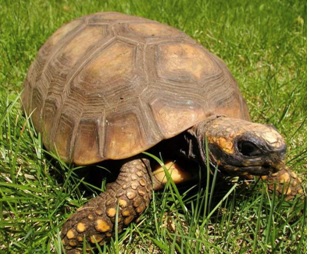Yellow-footed Tortoise
Scientific Classification
| Species |
Chelonoidis denticulatus |
| Kingdom | Animalia |
| Phylum | Chordata |
| Class | Reptilia |
| Order | Testudines |
| Family | Testudinidae |
| IUCN Status | Vulnerable |
Appearance and lifespan
The Yellow Footed Tortoise is black and has several yellow head scales and a horizontal bar behind its eye. There is quite a bit of variation in colouring, the legs and head often have patches of orange, yellow or red. The shell top is black with a small, distinct yellow area around each shell scale. The underside, or plastron, is a bland yellow-brown colour and the male tortoises tend to have a concave plastron. They range in length from 30 to 76 cm (11 to 29 inches) and can weigh an average of 15 kg (34lbs). Female tortoises tend to grow larger than the males. Yellow-footed tortoises can live 50 to 60 years.
Behaviour and reproduction
These tortoises make a sound like a baby cooing with a raspy voice. Tortoises also identify each other using body language. The male tortoise makes head movements toward other males, but the females do not make these head movements. Male tortoises also swing their heads back and forth in a continuous rhythm as a mating ritual. Mating occurs all year around for the Yellow Footed Tortoise.
The Yellow Footed Tortoise reaches the age of maturity at about 8 to 10 years. The number of eggs laid by a female generally depends on the size, the bigger they are, the more eggs they can produce. On average, a female will create approximately 6 to 16 eggs per year, although some female individuals may not reproduce each year. The eggs have brittle shells and are elongated to spherical, approximately 3 to 6 cm (1 to 2.3 inches) in diameter. The egg size will increase with the body size of the tortoise. The young are self-sufficient from birth.
Ecology and habitat
Yellow Footed Tortoises are found in South America. During recent times, humans have spread these tortoises throughout the world by trade. These tortoises like to build their nests in the dense rain forest, the tropical lowlands, or hidden in the growth of a thick forest.
This South American tortoise eats many kinds of foliage. In the wild, their diet consists of grasses, fallen fruit, carrion, plants, bones, mushrooms, excrement, and slow moving animals such as snails, worms, and others they can capture.
Food at the Zoo
At the Park & Zoo, the yellow-footed tortoise is fed an assortment of fresh fruits, vegetables, greens, occasional animal protein and commercial tortoise feed.
Threats
The biggest threat to the survival of yellow-footed tortoise is over-hunting by man. Yellow-foots are collected in large numbers and shipped to many different South American cities to be sold as a delicacy. Another threat facing yellow-foot populations is the ever-present habitat loss and disturbance. Exportation for the pet trade also has a negative effect on yellow-footed tortoises, although it is much less of a threat to their survival than either hunting or habitat loss. Conservation efforts include the establishment and protection of wildlife reserves and national parks, where yellow-footed tortoises and other animals are protected from hunting.
Did you know?
- Tortoises have domed carapaces (top shell) that offer protection from the snapping jaws of terrestrial predators.
- The shell of tortoise is made of 60 different bones and all are connected to each other.
- Tortoises do not have teeth.


